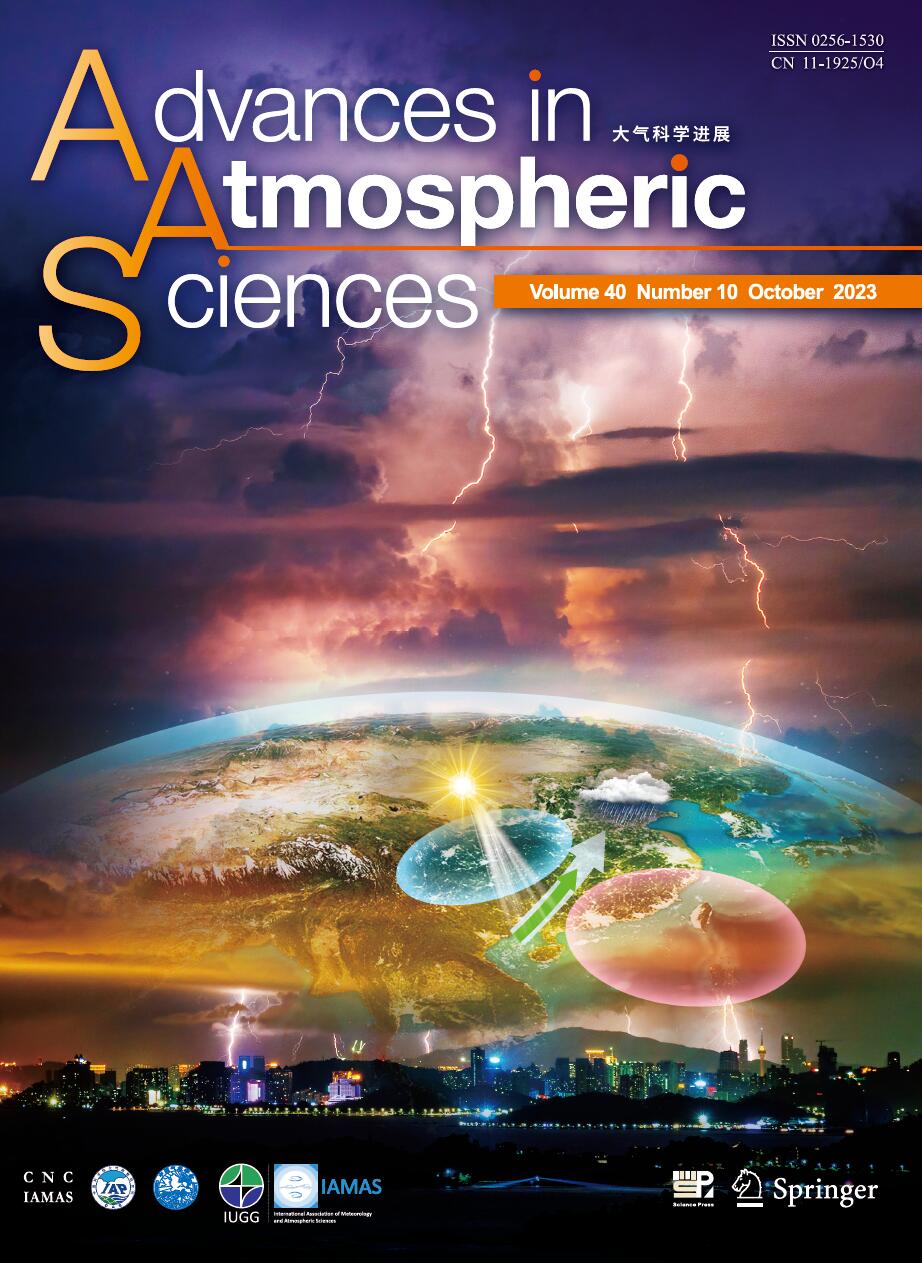| [1] |
CHEN Xiao, YAN Youfang, CHENG Xuhua, QI Yiquan,
2013: Performances of Seven Datasets in Presenting the Upper Ocean Heat Content in the South China Sea, ADVANCES IN ATMOSPHERIC SCIENCES, 30, 1331-1342.
doi: 10.1007/s00376-013-2132-1
|
| [2] |
Haoya LIU, Weibiao LI, Shumin CHEN, Rong FANG, Zhuo LI,
2018: Atmospheric Response to Mesoscale Ocean Eddies over the South China Sea, ADVANCES IN ATMOSPHERIC SCIENCES, 35, 1189-1204.
doi: 10.1007/s00376-018-7175-x
|
| [3] |
Lu Riyu, Chan-Su Ryu, Buwen Dong,
2002: Associations between the Western North Pacific Monsoon and the South China Sea Monsoon, ADVANCES IN ATMOSPHERIC SCIENCES, 19, 12-24.
doi: 10.1007/s00376-002-0030-z
|
| [4] |
Zi-Liang LI, Ping WEN,
2017: Comparison between the Response of the Northwest Pacific Ocean and the South China Sea to Typhoon Megi (2010), ADVANCES IN ATMOSPHERIC SCIENCES, 34, 79-87.
doi: 10.1007/s00376-016-6027-9
|
| [5] |
HU Wenting, WU Renguang,
2015: Relationship between South China Sea Precipitation Variability and Tropical Indo-Pacific SST Anomalies in IPCC CMIP5 Models during Spring-to-Summer Transition, ADVANCES IN ATMOSPHERIC SCIENCES, 32, 1308-1318.
doi: 10.1007/s00376-015-4250-4
|
| [6] |
LIU Qinyu, WU Shu, YANG Jianling, HU Haibo, HU Ruijin, LI Lijuan,
2006: A Review of Ocean-Atmosphere Interaction Studies in China, ADVANCES IN ATMOSPHERIC SCIENCES, 23, 982-991.
doi: 10.1007/s00376-006-0982-5
|
| [7] |
Peter C. Chu, C.-P. Chang,
1997: South China Sea Warm Pool in Boreal Spring, ADVANCES IN ATMOSPHERIC SCIENCES, 14, 195-206.
doi: 10.1007/s00376-997-0019-8
|
| [8] |
Liu Qinyu, Jia Yinglai, Wang Xiaohua, Yang Haijun,
2001: On the Annual Cycle Characteristics of the Sea Surface Height in South China Sea, ADVANCES IN ATMOSPHERIC SCIENCES, 18, 613-622.
doi: 10.1007/s00376-001-0049-6
|
| [9] |
ZHOU Lian-Tong, Chi-Yung TAM, ZHOU Wen, Johnny C. L. CHAN,
2010: Influence of South China Sea SST and the ENSO on Winter Rainfall over South China, ADVANCES IN ATMOSPHERIC SCIENCES, 27, 832-844.
doi: 10.1007/s00376--009-9102-7
|
| [10] |
ZHAO Xia, LI Jianping,
2009: Possible Causes for the Persistence Barrier of SSTA in the South China Sea and the Vicinity of Indonesia, ADVANCES IN ATMOSPHERIC SCIENCES, 26, 1125-1136.
doi: 10.1007/s00376-009-8165-9
|
| [11] |
Yan Junyue,
1997: Observational Study on the Onset of the South China Sea Southwest Monsoon, ADVANCES IN ATMOSPHERIC SCIENCES, 14, 277-287.
doi: 10.1007/s00376-997-0026-9
|
| [12] |
Hailong LIU, Pingxiang Chu, Yao Meng, Mengrong DING, Pengfei LIN, Ruiqiang Ding, Pengfei Wang, Weipeng ZHENG,
2024: The Predictability Limit of Oceanic Mesoscale Eddy Tracks in the South China Sea, ADVANCES IN ATMOSPHERIC SCIENCES.
doi: 10.1007/s00376-024-3250-7
|
| [13] |
Yang Haijun, Liu Qinyu, Jia Xujing,
1999: On the Upper Oceanic Heat Budget in the South China Sea: Annual Cycle, ADVANCES IN ATMOSPHERIC SCIENCES, 16, 619-629.
doi: 10.1007/s00376-999-0036-x
|
| [14] |
Shumin CHEN, Weibiao LI, Zhiping WEN, Mingsen ZHOU, Youyu LU, Yu-Kun QIAN, Haoya LIU, Rong FANG,
2018: Variations in High-frequency Oscillations of Tropical Cyclones over the Western North Pacific, ADVANCES IN ATMOSPHERIC SCIENCES, 35, 423-434.
doi: 10.1007/s00376-017-7060-z
|
| [15] |
Jiangyu MAO, Ming WANG,
2018: The 30-60-day Intraseasonal Variability of Sea Surface Temperature in the South China Sea during May-September, ADVANCES IN ATMOSPHERIC SCIENCES, 35, 550-566.
doi: 10.1007/s00376-017-7127-x
|
| [16] |
Qingwei ZENG, Yun ZHANG, Hengchi LEI, Yanqiong XIE, Taichang GAO, Lifeng ZHANG, Chunming WANG, Yanbin HUANG,
2019: Microphysical Characteristics of Precipitation during Pre-monsoon, Monsoon, and Post-monsoon Periods over the South China Sea, ADVANCES IN ATMOSPHERIC SCIENCES, 36, 1103-1120.
doi: 10.1007/s00376-019-8225-8
|
| [17] |
Hepeng ZHENG, Yun ZHANG, Lifeng ZHANG, Hengchi LEI, Zuhang WU,
2021: Precipitation Microphysical Processes in the Inner Rainband of Tropical Cyclone Kajiki (2019) over the South China Sea Revealed by Polarimetric Radar, ADVANCES IN ATMOSPHERIC SCIENCES, 38, 65-80.
doi: 10.1007/s00376-020-0179-3
|
| [18] |
Peng HU, Wen CHEN, Shangfeng CHEN, Lin WANG, Yuyun LIU,
2022: The Weakening Relationship between ENSO and the South China Sea Summer Monsoon Onset in Recent Decades, ADVANCES IN ATMOSPHERIC SCIENCES, 39, 443-455.
doi: 10.1007/s00376-021-1208-6
|
| [19] |
LIU Yanju, DING Yihui,
2007: Sensitivity Study of the South China Sea Summer Monsoon in 1998 to Different Cumulus arameterization Schemes, ADVANCES IN ATMOSPHERIC SCIENCES, 24, 360-376.
doi: 10.1007/s00376-007-0360-y
|
| [20] |
LI Xiangshu, GUO Xueliang, FU Danhong,
2013: TRMM-retrieved Cloud Structure and Evolution of MCSs over the Northern South China Sea and Impacts of CAPE and Vertical Wind Shear, ADVANCES IN ATMOSPHERIC SCIENCES, 30, 77-88.
doi: 10.1007/s00376-012-2055-2
|















 AAS Website
AAS Website 
 AAS WeChat
AAS WeChat 
 DownLoad:
DownLoad: